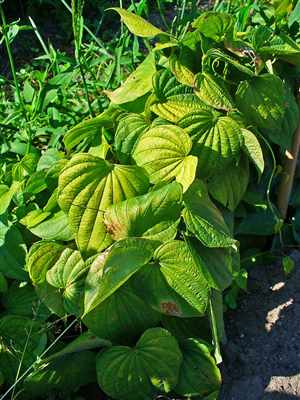Wild Yam (Dioscorea villosa)
Main Facts about Wild Yam

Found in damp, woodland areas, Wild Yam is a deciduous vine up to 30 feet long with heart-shaped leaves, small, greenish white flowers, and creeping woody roots with tuberous rhizomes.The plant flowers from June to August. Parts used – roots and tuber.
The Wild Yam is native to North America and has been naturalized throughout the warmer regions of the world. There are approximately 800 species in the genus Dioscorea – a group of tropical and subtropical climbing plants. While some Yam species produce tasty, edible tubers, the tubers of Dioscorea villosa are bitter and used primarily for medicinal purposes, especially to relieve abdominal cramping.
Using Wild Yam
Wild Yam root has a history of medicinal use for cramping or contractions in the pelvic area, such as intestinal and bilious colic, flatulence, ovarian and uterine pain; for poor circulation and neuralgia, and for abdominal and intestinal cramping. Wild Yam can be very beneficial for nervousness, restlessness and other nervous conditions.
Wild Yam's traditional use is for easing menstrual cramps. Though Wild Yam has been claimed to alleviate symptoms of menopause, but studies have found it to be no more effective than a placebo.
Wild Yam contains a steroid-like compound called diosgenin that once was used in contraceptives hormones such as birth control pills. Diosgenin is a phytoestrogen, or plant-based estrogen, that can be chemically converted into a hormone called progesterone. Yet, studies have found that the body cannot change diosgenin into progesterone; it has to be done in a lab. Wild yam, by itself, does not contain progesterone.
Many Wild Yam creams (mostly marketed to ease menopausal symptoms) contain human progesterone created in a laboratory, often synthetically derived from diosgenin.
Wild Yam can be taken in capsules or in tea. The powder can be added to creams or vaginal ointments.
How to grow Wild Yam
Wild Yam thrives in rich, well-drained, moist soil in sun or partial shade. Each root comes with several “eyes” that can be broken off and planted individually.
Wild yam “eyes” or roots may be planted anytime in fall until the ground freezes or they can be planted in pots, kept inside till spring and then replanted outdoors. Commercial preparations use the dried roots, which are harvested in fall. They may be dug up in the third or later year and dried. Leave behind some roots or “eyes” for future growth. They should not be stored for longer than one year, since they are likely to lose their medicinal value.
| Wheatgrass |
Witch Hazel
|